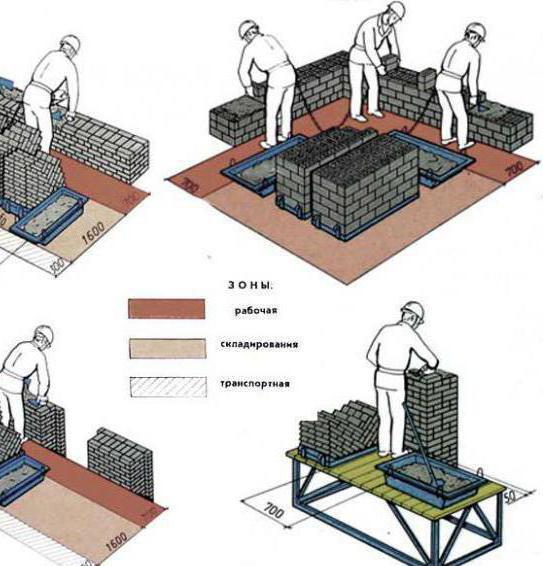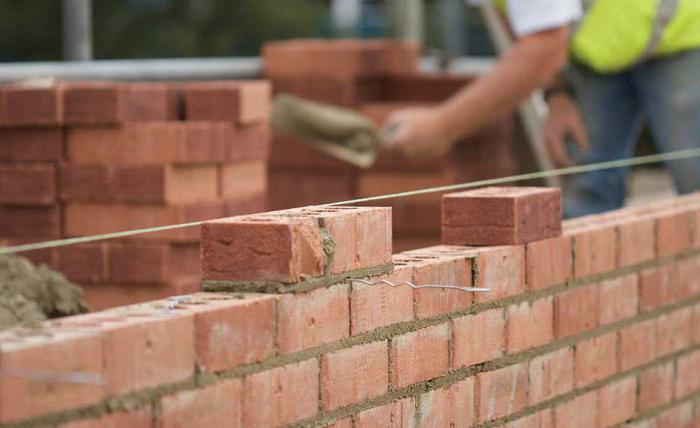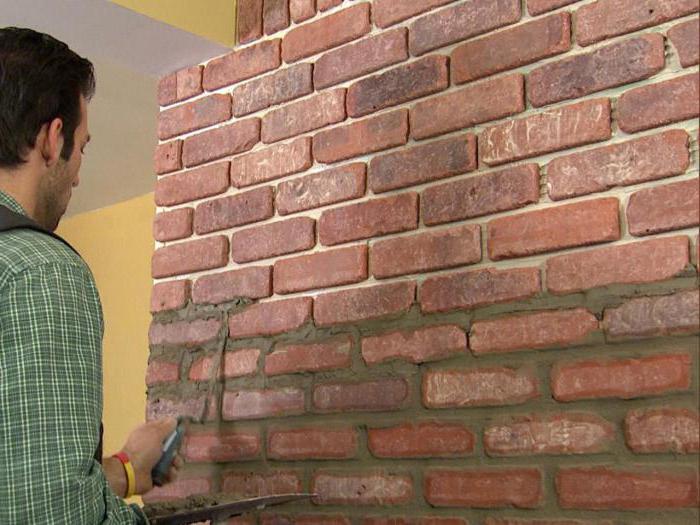The place where the mason works is a wall that he erects, as well as a small section of the territory adjacent to it. All the tools necessary for the job are located here. Consider the organization of a mason's workplace. Every detail here is of great importance, the proper organization of the process increases the productivity of the entire team.
What zones does the workspace consist of? Mason Workplace Organization Scheme
The area in which the mason performs his immediate duties is about 2.5 meters wide and length, depending on the structure being constructed. It is divided into three parts.
Work zone. This is the area in which workers move freely around masonry.
The area where the working material, mortar and parts used to build a brick wall are located is called the material zone.
Transportation area. To move the necessary material and parts for laying walls, as well as for the passage of people.

Where is the walling material located?
During laying, all material is placed along the wall being erected. In this case, bricks lying on pallets and mortar for laying in boxes alternate in the material zone.
The distance between the drawers with solutions should not be more than three meters. This is necessary for the convenience of work. In this case, the long side of the box should be located away from the wall.
Do not put boxes with materials far from workers. The stock of the solution should be optimal, its amount is calculated for 45 minutes of operation, the excess can lose its physical properties and freeze.

Activities for laying the wall
The organization of the mason's workplace when laying the wall is as follows:
During work aimed at laying the wall, boxes with bricks are placed opposite it. At the same time, during the laying of the pillars, the solution should be on the right side, and bricks on the left.
Bricks should be stocked in such a quantity that they are enough for a bricklayer to work for two to four hours.
The solution is prepared before the masonry procedure.
It is not worth overloading the working area with materials, this will interfere with the established work of the construction team.
The organization of the workplace and the work of the bricklayer when laying without facing
In this case, boxes with mortar and pallets with bricks are laid out in a row in the material zone.
If facing is planned, then the material is placed in several rows. First comes brick and mortar, and then materials for wall cladding.

What determines the efficiency of a bricklayer?
The productivity of a bricklayer depends on the height of the masonry. For example, at its rate of 10-40 centimeters, labor productivity is 66%, at a height of 60-80 centimeters it is 99%, and at 100-150 centimeters - 75%. We can conclude that it is much more comfortable for a mason to work with a masonry height slightly below his belt.
Work in the links. "Two"
Brigades consist of links. They are called "deuces", "triples", "fives" and so on. It depends on how many people work in the team.
The organization of the workplace of the masons in the "deuce" is as follows:
Both workers fasten berths for versts - both internal, and external.
Workers are divided into a leading mason and utility worker.At the same time, the auxiliary is engaged in the supply, unfolding of brick and mortar, and the second worker is laying the outer verst.
They lay the inner milestone in the same way, moving in the opposite direction.
"Two" works on laying walls up to one and a half bricks. Lay walls with many openings, partitions and pillars.

Work of a link of masons: “three”
"Three" consists of a mason of the fourth or fifth category, called the leader, and two masons of the second or third category.
The leading bricklayer puts the verst rows and checks if the masonry is correctly laid. He goes for the utility room, which spreads the solution.
Another mason at this very time is laying the rubble. The laying of both versts is carried out in equal order, but at the same time they go in opposite directions.
The mooring is rearranged by the auxiliary and the leading bricklayer.
This link works with walls with a thickness of two or two and a half bricks. Moreover, their labor productivity is higher than that of the "deuce", by thirty percent.
Work of a link of masons: "five"
The "Five" includes the masters of the fourth and third categories and three masons, called auxiliary workers, with the second category.
An external milestone is laid by a leading bricklayer and one utility room. After three meters, the second leading bricklayer with a utility room creates an internal one. The whole thing closes the back room, which puts the clue.
This team works on walls with a thickness of more than two bricks, and during the laying of openings they are divided into links of two and three people.

Styling corners
The organization of the mason’s workplace when laying the corners is as follows: along the masonry leave free space between sixty and seventy centimeters wide, the bricks in the pallets are placed as close to the corner as possible, and the boxes with mortar are placed so that the long side is along the wall.
Brick is stored for two to four hours.
Laying wall sections called deaf
The organization of the mason’s workplace in this case is carried out according to the following scheme. The workplace should be about two and a half meters wide (the working area is seventy centimeters, the material location area is one hundred and sixty centimeters, and the passage area is forty centimeters).
Laying walls with openings
The organization of the mason’s workplace is as follows: the solution in the boxes is placed opposite the opening at a distance of four meters from each other. The bricks are opposite the wall. During the laying of blind areas, the material is alternated.